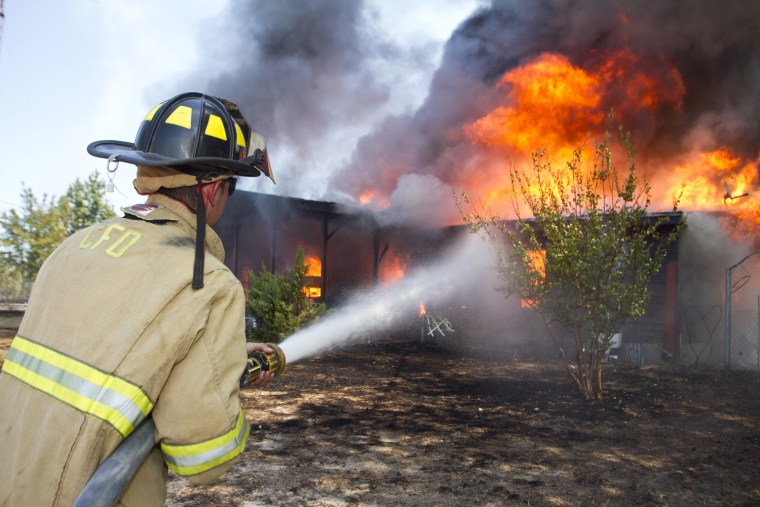A deadly and enormously destructive wildfire was still burning on Friday southeast of Austin, but county officials said the nearly 850 firefighters battling the blaze continue to make progress in containing the historic fire.
Firefighters held firm on the frontlines, tamping down hotspots and holding back flames from a wildfire that has burned for days across Central Texas, incinerating nearly 1,400 homes and tens of thousands of acres of drought-parched land.
The fire in and around Bastrop, about 25 miles east of Austin, officially remained 30 percent contained, but crews had surrounded and closed in on the flames, protecting structures. No new homes were reported destroyed overnight.
"It seems to be holding well today," public information officer Annette Grijalva-Disert said.
Authorities had planned Friday to deploy a converted DC-10 jetliner capable of dropping 12,000 gallons of fire retardant on the blaze, but Texas Forest Service spokeswoman Holly Huffman said the massive plane was not immediately needed in Bastrop and was instead sent to fires burning in a mostly rural area north of Houston.
Retardant is dropped to help shorten and shrink flames, allowing firefighters on the ground to make headway, but it does not extinguish the fire.
"What puts fires out, what's most effective are the men and women on the ground," said Tom Harbour, national fire director for the U.S. Forest Service.
Firefighters from across the country continue to pour into Bastrop, and Texas Forest Service incident manager Bob Koenig said 844 were on the fire line there Friday.
Frustrations and progress in historic Texas wildfire Huffman agreed firefighting crews have made significant strides in Bastrop County and said the jet "can be diverted at any point if a new fire pops up," but it was first sent to blazes in Grimes, Montgomery and Waller counties that have blackened about 15,000 acres 40 miles northwest of Houston.
Texas is in the midst of its worst wildfire outbreak in state history. The Bastrop-area fire has been the largest of nearly 190 wildfires the forest service says erupted this week, leaving nearly 1,700 homes statewide in charred ruins, killing four people and forcing thousands of people to evacuate.
Federal forest service officials earlier this week contacted 10 Tanker Air Carrier LLC, of Victorville, Calif., which leases the DC-10 to the U.S. Forest Service and states as needed. The state asked that the company "ferry it as quickly as possible" to Texas, which also used the tanker in the spring, said CEO Rick Hatton.
The massive plane arrived Tuesday night in Austin, about 25 miles west of the blaze, but could not be used until Friday as crews worked to set a temporary plumbing system to funnel retardant into the plane, said Texas Forest Service spokeswoman Holly Huffman.
Huffman said Texas has retardant plants in place at airports other than Austin, but runways at those sites are neither approved to handle such a large aircraft. She said the DC-10 — which costs the state $12,000 per flight hour as well as a $45,000 per day availability fee — is used in addition to smaller aircraft.
"These tankers aren't magic tools, rather they help to slow down and cool down the fire," she said. "Ground resources still have to go in and contain and extinguish the fire."
Officials on Thursday allowed some of the 5,000 evacuated Bastrop-area residents to return to areas no longer considered threatened, including hundreds of homes in the Tahitian Village neighborhood. Most there appeared untouched, but the pockets of destruction were complete.
Mary Pierce, who for 22 years lived on a quiet street where pines push up into backyards, stared in disbelief Thursday at her foundation, where all that stood was a brick facade and a chimney. Lumped metal appliances suggested a kitchen or laundry room; a metal bed frame, a bedroom.
"When they say things burn to the ground, they really mean burn to the ground," said Pierce, who was one of only two residents to lose a home on her block.
The Associated Press and Reuters contributed to this report.
